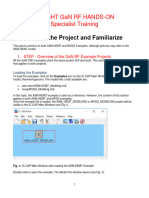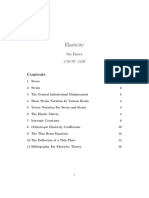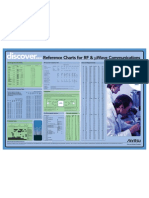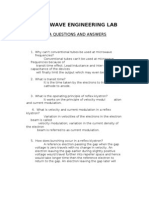Circuit Symmetry-Method To Solve Problems
Uploaded by
sanits591Circuit Symmetry-Method To Solve Problems
Uploaded by
sanits5913/4/2009
Circuit Symmetry
1/14
Circuit Symmetry
One of the most powerful
concepts in for evaluating circuits
is that of symmetry. Normal
humans have a conceptual
understanding of symmetry, based
on an esthetic perception of
structures and figures.
variste Galois
On the other hand, mathematicians (as they
are wont to do) have defined symmetry in a
very precise and unambiguous way. Using a
branch of mathematics called Group
Theory, first developed by the young genius
variste Galois (1811-1832), symmetry is
defined by a set of operations (a group)
that leaves an object unchanged.
Initially, the symmetric objects under consideration by
Galois were polynomial functions, but group theory can
likewise be applied to evaluate the symmetry of structures.
For example, consider an ordinary
equilateral triangle; we find that it is a
highly symmetric object!
Jim Stiles
The Univ. of Kansas
Dept. of EECS
3/4/2009
Circuit Symmetry
2/14
Q: Obviously this is true. We dont need a mathematician to
tell us that!
A: Yes, but how symmetric is it? How does the symmetry of
an equilateral triangle compare to that of an isosceles
triangle, a rectangle, or a square?
To determine its level of symmetry, lets first label each
corner as corner 1, corner 2, and corner 3.
2
First, we note that the triangle exhibits a plane of reflection
symmetry:
2
Jim Stiles
The Univ. of Kansas
Dept. of EECS
3/4/2009
Circuit Symmetry
3/14
Thus, if we reflect the triangle across this plane we get:
Note that although corners 1 and 3 have changed places, the
triangle itself remains unchangedthat is, it has the same
shape, same size, and same orientation after reflecting across
the symmetric plane!
Mathematicians say that these two triangles are congruent.
Note that we can write this reflection operation as a
permutation (an exchange of position) of the corners, defined
as:
13
22
31
Q: But wait! Isnt there is more than just one plane of
reflection symmetry?
A: Definitely! There are two more:
Jim Stiles
The Univ. of Kansas
Dept. of EECS
3/4/2009
Circuit Symmetry
4/14
1
12
21
33
3
1 1
23
32
In addition, an equilateral triangle exhibits rotation
symmetry!
Rotating the triangle 120D clockwise also results in a
congruent triangle:
2
12
23
31
Likewise, rotating the triangle 120D counter-clockwise results
in a congruent triangle:
Jim Stiles
The Univ. of Kansas
Dept. of EECS
3/4/2009
Circuit Symmetry
5/14
13
21
32
Additionally, there is one more operation that will result in a
congruent triangledo nothing!
2
1 1
22
33
This seemingly trivial operation is known as the identity
operation, and is an element of every symmetry group.
These 6 operations form the dihedral symmetry group D3
which has order six (i.e., it consists of six operations). An
object that remains congruent when operated on by any and
all of these six operations is said to have D3 symmetry.
An equilateral triangle has D3 symmetry!
By applying a similar analysis to a isosceles triangle, rectangle,
and square, we find that:
Jim Stiles
The Univ. of Kansas
Dept. of EECS
3/4/2009
Circuit Symmetry
D1
6/14
An isosceles trapezoid has D1 symmetry, a
dihedral group of order 2.
D2
A rectangle has D2 symmetry, a dihedral group
of order 4.
D4
A square has D4 symmetry, a dihedral group of
order 8.
Thus, a square is the most symmetric object of the four we
have discussed; the isosceles trapezoid is the least.
Q: Well thats all just fascinatingbut just what the heck
does this have to do with microwave circuits!?!
A: Plenty! Useful circuits often display high levels of
symmetry.
For example consider these D1 symmetric multi-port circuits:
12
Port 1
200
21
34
Port 2
50
200
100
4 3
Port 4
Port 3
Jim Stiles
The Univ. of Kansas
Dept. of EECS
3/4/2009
13
Circuit Symmetry
Port 1
100
24
Port 2
50
31
7/14
200
50
4 2
Port 4
Port 3
Or this circuit with D2 symmetry:
Port 1
200
50
Port 2
200
50
Port 4
Port 3
which is congruent under these permutations:
Jim Stiles
13
12
14
24
21
23
31
34
32
4 2
4 3
4 1
The Univ. of Kansas
Dept. of EECS
3/4/2009
Circuit Symmetry
8/14
Or this circuit with D4 symmetry:
50
Port 1
Port 2
50
50
50
Port 4
Port 3
which is congruent under these permutations:
13
12
14
14
1 1
24
21
23
22
23
31
34
32
33
32
4 2
4 3
4 1
4 1
44
The importance of this can be seen when considering the
scattering matrix, impedance matrix, or admittance matrix of
these networks.
For example, consider again this symmetric circuit:
Port 1
Port 2
50
200
200
100
Port 4
Port 3
Jim Stiles
The Univ. of Kansas
Dept. of EECS
3/4/2009
Circuit Symmetry
9/14
This four-port network has a single plane of reflection
symmetry (i.e., D1 symmetry), and thus is congruent under the
permutation:
12
21
34
4 3
So, since (for example) 1 2 , we find that for this circuit:
S11 = S22
Z 11 = Z 22
Y11 = Y22
must be true!
Or, since 1 2 and 3 4 we find:
S13 = S24
Z 13 = Z 24
Y13 = Y24
S31 = S42
Z 31 = Z 42
Y31 = Y42
Continuing for all elements of the permutation, we find that
for this symmetric circuit, the scattering matrix must have
this form:
S11 S21 S13 S14
S
S11 S14 S13
21
S=
S
S
S
S
31
33
41
43
S
S
S
S
31
33
41
43
Jim Stiles
The Univ. of Kansas
Dept. of EECS
3/4/2009
Circuit Symmetry
10/14
and the impedance and admittance matrices would likewise
have this same form.
Note there are just 8 independent elements in this matrix. If
we also consider reciprocity (a constraint independent of
symmetry) we find that S31 = S13 and S41 = S14 , and the matrix
reduces further to one with just 6 independent elements:
S11 S21 S31 S41
S
S11 S41 S31
21
S=
S31 S41 S33 S43
S
41 S31 S43 S33
Or, for circuits with this D1 symmetry:
Port 1
13
100
24
Port 2
200
50
31
4 2
50
Port 4
Port 3
S11 S21 S31 S41
S
S22 S41 S31
21
S=
S
S
S
S
31
11
21
41
S
S
S
S
31
21
2
2
4
1
Q: Interesting. But why do we care?
Jim Stiles
The Univ. of Kansas
Dept. of EECS
3/4/2009
Circuit Symmetry
11/14
A: This will greatly simplify the analysis of this symmetric
circuit, as we need to determine only six matrix elements!
For a circuit with D2 symmetry:
Port 1
200
50
200
Port 2
50
Port 4
Port 3
we find that the impedance (or scattering, or admittance)
matrix has the form:
Z 11
Z
Z = 21
Z 31
Z 41
Z 21 Z 31 Z 41
Z 11 Z 41 Z 31
Z 41 Z 11 Z 21
Z 31 Z 21 Z 11
Note here that there are just four independent values!
Jim Stiles
The Univ. of Kansas
Dept. of EECS
3/4/2009
Circuit Symmetry
12/14
For a circuit with D4 symmetry:
50
Port 1
50
Port 2
50
50
Port 4
Port 3
we find that the admittance (or scattering, or impedance)
matrix has the form:
Y11
Y
21
Y=
Y21
Y41
Y21
Y11
Y41
Y21
Y21
Y41
Y11
Y21
Y41
Y21
Y21
Y11
Note here that there are just three independent values!
One more interesting thing (yet another one!); recall that we
earlier found that a matched, lossless, reciprocal 4-port
device must have a scattering matrix with one of two forms:
Jim Stiles
The Univ. of Kansas
Dept. of EECS
3/4/2009
S=
j
Circuit Symmetry
0
0
S=
0
0
j
13/14
The symmetric solution
0
0
0
0
The anti-symmetric solution
Compare these to the matrix forms above. The symmetric
solution has the same form as the scattering matrix of a
circuit with D2 symmetry!
0
S=
j
0
0
0
j
Q: Does this mean that a matched, lossless, reciprocal four-
port device with the symmetric scattering matrix must
exhibit D2 symmetry?
A: Thats exactly what it means!
Jim Stiles
The Univ. of Kansas
Dept. of EECS
3/4/2009
Circuit Symmetry
14/14
Not only can we determine from the form of the scattering
matrix whether a particular design is possible (e.g., a matched,
lossless, reciprocal 3-port device is impossible), we can also
determine the general structure of a possible solutions (e.g.
the circuit must have D2 symmetry).
Likewise, the anti-symmetric matched, lossless, reciprocal
four-port network must exhibit D1 symmetry!
0
0
S=
0
0
0
0
0
Well see just what these symmetric, matched, lossless,
reciprocal four-port circuits actually are later in the course!
Jim Stiles
The Univ. of Kansas
Dept. of EECS
You might also like
- Spectrerf Workshop: Power Amplifier Design Using Spectrerf Mmsim 7.2.0No ratings yetSpectrerf Workshop: Power Amplifier Design Using Spectrerf Mmsim 7.2.091 pages
- Section 3G Dividers and Couplers PackageNo ratings yetSection 3G Dividers and Couplers Package27 pages
- Section 7 5 The Quadrature Hybrid PackageNo ratings yetSection 7 5 The Quadrature Hybrid Package19 pages
- Elastic Properties and Anisotropy of Elastic BehaviorNo ratings yetElastic Properties and Anisotropy of Elastic Behavior44 pages
- Hong Yao, Shou-Cheng Zhang and Steven A. Kivelson - Algebraic Spin Liquid in An Exactly Solvable Spin ModelNo ratings yetHong Yao, Shou-Cheng Zhang and Steven A. Kivelson - Algebraic Spin Liquid in An Exactly Solvable Spin Model4 pages
- Ministry of Education St. Mary'S School Math and Physics Department 12 - Physics: Kirchhoff S LawsNo ratings yetMinistry of Education St. Mary'S School Math and Physics Department 12 - Physics: Kirchhoff S Laws11 pages
- MO 201: Materials Science: DR Bratindranath Mukherjee Dept. of Metallurgical Engineering Bratindra - Met@itbhu - Ac.inNo ratings yetMO 201: Materials Science: DR Bratindranath Mukherjee Dept. of Metallurgical Engineering Bratindra - Met@itbhu - Ac.in109 pages
- Y X X Y: Warm Up: Sketch The Graphs Below. (This Is Going To Get You Thinking About Our Next Topic, Parabolas.)No ratings yetY X X Y: Warm Up: Sketch The Graphs Below. (This Is Going To Get You Thinking About Our Next Topic, Parabolas.)7 pages
- P.G. Kevrekidis Et Al - Three-Dimensional Solitary Waves and Vortices in A Discrete Nonlinear Schrodinger LatticeNo ratings yetP.G. Kevrekidis Et Al - Three-Dimensional Solitary Waves and Vortices in A Discrete Nonlinear Schrodinger Lattice4 pages
- Analytical and Experimental Study of Vibration Behavior of FRP Composite I-BeamsNo ratings yetAnalytical and Experimental Study of Vibration Behavior of FRP Composite I-Beams8 pages
- Sem 1 Unit 3 Crystal Structure Final NotesNo ratings yetSem 1 Unit 3 Crystal Structure Final Notes63 pages
- Matt Visser - Traversable Wormholes: Some Simple ExamplesNo ratings yetMatt Visser - Traversable Wormholes: Some Simple Examples7 pages
- Emmanuel N. Saridakis and Sergey V. Sushkov - Quintessence and Phantom Cosmology With Non-Minimal Derivative CouplingNo ratings yetEmmanuel N. Saridakis and Sergey V. Sushkov - Quintessence and Phantom Cosmology With Non-Minimal Derivative Coupling8 pages
- Analysis and Design of Coupled Line CouplersNo ratings yetAnalysis and Design of Coupled Line Couplers11 pages
- On The Effective Dielectric Permittivity of Nanocomposite StructuresNo ratings yetOn The Effective Dielectric Permittivity of Nanocomposite Structures8 pages
- Georg Cantor (1845-1918) :: The Man Who Tamed InfinityNo ratings yetGeorg Cantor (1845-1918) :: The Man Who Tamed Infinity33 pages
- s00454 004 1146 Computing Persistent HomolgyNo ratings yets00454 004 1146 Computing Persistent Homolgy26 pages
- Section 7 6 Coupled Line Directional Couplers PackageNo ratings yetSection 7 6 Coupled Line Directional Couplers Package24 pages
- Finite Element Beam Vibration: Department of Mechanical, Aerospace and Manufacturing EngineeringNo ratings yetFinite Element Beam Vibration: Department of Mechanical, Aerospace and Manufacturing Engineering4 pages
- Paralinearization of The Dirichlet To Neumann Operator, and Regularity of Three-Dimensional Water WavesNo ratings yetParalinearization of The Dirichlet To Neumann Operator, and Regularity of Three-Dimensional Water Waves76 pages
- Crystal and Amorphous Structure in MaterialsNo ratings yetCrystal and Amorphous Structure in Materials57 pages
- Voltage Magnification by Standing WavesNo ratings yetVoltage Magnification by Standing Waves10 pages
- IIT-JEE-2011 Chemistry Paper Ii Solution Paper Code 4: Detailed AnswersNo ratings yetIIT-JEE-2011 Chemistry Paper Ii Solution Paper Code 4: Detailed Answers10 pages
- Photo Electric Effect: 1 - Properties of PhotonsNo ratings yetPhoto Electric Effect: 1 - Properties of Photons1 page
- Challenge-2003-12 - Rocket From The Pocket - Spinning The Reel - High JumpNo ratings yetChallenge-2003-12 - Rocket From The Pocket - Spinning The Reel - High Jump3 pages
- Challenge-2003-9 - The Road Rage - Riverdance - The Flight of The BumblebeeNo ratings yetChallenge-2003-9 - The Road Rage - Riverdance - The Flight of The Bumblebee2 pages
- Challenge-2003-2 - Shake and Bake - Track and Field - Current AffairsNo ratings yetChallenge-2003-2 - Shake and Bake - Track and Field - Current Affairs2 pages
- Challenge-2003-1 - Out in The Field - in Hot Water - The World On A SpringNo ratings yetChallenge-2003-1 - Out in The Field - in Hot Water - The World On A Spring2 pages
- Current Electricity Target Publications Jee Main Physics II100% (3)Current Electricity Target Publications Jee Main Physics II40 pages
- 20 Test-1 Err:504 Test-1 Test-1 1 Test-2 Err:504 Test-2 Test-2 Err:504 Err:504 Err:504No ratings yet20 Test-1 Err:504 Test-1 Test-1 1 Test-2 Err:504 Test-2 Test-2 Err:504 Err:504 Err:5046 pages
- CST STUDIO SUITE - High Frequency Simulation PDF100% (2)CST STUDIO SUITE - High Frequency Simulation PDF128 pages
- Six-Port Interferometer For Direction-of-Arrival Detection SystemNo ratings yetSix-Port Interferometer For Direction-of-Arrival Detection System4 pages
- Modeling and Simulation of Frequency Reconfigurable Microstrip Patch Antenna For Wimax ApplicationsNo ratings yetModeling and Simulation of Frequency Reconfigurable Microstrip Patch Antenna For Wimax Applications54 pages
- Matching Circuit Optimization For Antenna ApplicationsNo ratings yetMatching Circuit Optimization For Antenna Applications4 pages
- Chapt.3-Transmission Line, Imped Transformation, 2-Port NetNo ratings yetChapt.3-Transmission Line, Imped Transformation, 2-Port Net46 pages
- Introduction to RF Design Using EM Simulators Artech House Microwave Library Hiroaki Kogure - Instantly access the full ebook content in just a few seconds100% (2)Introduction to RF Design Using EM Simulators Artech House Microwave Library Hiroaki Kogure - Instantly access the full ebook content in just a few seconds78 pages
- Modified Nicolson-Ross-Weir (NRW) Method To Retrieve The Constitutive Parameters of Low-Loss MaterialsNo ratings yetModified Nicolson-Ross-Weir (NRW) Method To Retrieve The Constitutive Parameters of Low-Loss Materials5 pages
- RF Toolbox 2.8: Design, Model, and Analyze Networks of RF ComponentsNo ratings yetRF Toolbox 2.8: Design, Model, and Analyze Networks of RF Components5 pages
- 2019 Book MicrowaveActiveDevicesAndCircuNo ratings yet2019 Book MicrowaveActiveDevicesAndCircu700 pages
- Instant Download Microwave Measurements 3rd Edition R. Collier PDF All Chapters100% (5)Instant Download Microwave Measurements 3rd Edition R. Collier PDF All Chapters61 pages
- Spectrerf Workshop: Power Amplifier Design Using Spectrerf Mmsim 7.2.0Spectrerf Workshop: Power Amplifier Design Using Spectrerf Mmsim 7.2.0
- Elastic Properties and Anisotropy of Elastic BehaviorElastic Properties and Anisotropy of Elastic Behavior
- Hong Yao, Shou-Cheng Zhang and Steven A. Kivelson - Algebraic Spin Liquid in An Exactly Solvable Spin ModelHong Yao, Shou-Cheng Zhang and Steven A. Kivelson - Algebraic Spin Liquid in An Exactly Solvable Spin Model
- Ministry of Education St. Mary'S School Math and Physics Department 12 - Physics: Kirchhoff S LawsMinistry of Education St. Mary'S School Math and Physics Department 12 - Physics: Kirchhoff S Laws
- MO 201: Materials Science: DR Bratindranath Mukherjee Dept. of Metallurgical Engineering Bratindra - Met@itbhu - Ac.inMO 201: Materials Science: DR Bratindranath Mukherjee Dept. of Metallurgical Engineering Bratindra - Met@itbhu - Ac.in
- Y X X Y: Warm Up: Sketch The Graphs Below. (This Is Going To Get You Thinking About Our Next Topic, Parabolas.)Y X X Y: Warm Up: Sketch The Graphs Below. (This Is Going To Get You Thinking About Our Next Topic, Parabolas.)
- P.G. Kevrekidis Et Al - Three-Dimensional Solitary Waves and Vortices in A Discrete Nonlinear Schrodinger LatticeP.G. Kevrekidis Et Al - Three-Dimensional Solitary Waves and Vortices in A Discrete Nonlinear Schrodinger Lattice
- Analytical and Experimental Study of Vibration Behavior of FRP Composite I-BeamsAnalytical and Experimental Study of Vibration Behavior of FRP Composite I-Beams
- Matt Visser - Traversable Wormholes: Some Simple ExamplesMatt Visser - Traversable Wormholes: Some Simple Examples
- Emmanuel N. Saridakis and Sergey V. Sushkov - Quintessence and Phantom Cosmology With Non-Minimal Derivative CouplingEmmanuel N. Saridakis and Sergey V. Sushkov - Quintessence and Phantom Cosmology With Non-Minimal Derivative Coupling
- On The Effective Dielectric Permittivity of Nanocomposite StructuresOn The Effective Dielectric Permittivity of Nanocomposite Structures
- Georg Cantor (1845-1918) :: The Man Who Tamed InfinityGeorg Cantor (1845-1918) :: The Man Who Tamed Infinity
- Section 7 6 Coupled Line Directional Couplers PackageSection 7 6 Coupled Line Directional Couplers Package
- Finite Element Beam Vibration: Department of Mechanical, Aerospace and Manufacturing EngineeringFinite Element Beam Vibration: Department of Mechanical, Aerospace and Manufacturing Engineering
- Paralinearization of The Dirichlet To Neumann Operator, and Regularity of Three-Dimensional Water WavesParalinearization of The Dirichlet To Neumann Operator, and Regularity of Three-Dimensional Water Waves
- Solved Problems in Classical ElectromagnetismFrom EverandSolved Problems in Classical Electromagnetism
- IIT-JEE-2011 Chemistry Paper Ii Solution Paper Code 4: Detailed AnswersIIT-JEE-2011 Chemistry Paper Ii Solution Paper Code 4: Detailed Answers
- Challenge-2003-12 - Rocket From The Pocket - Spinning The Reel - High JumpChallenge-2003-12 - Rocket From The Pocket - Spinning The Reel - High Jump
- Challenge-2003-9 - The Road Rage - Riverdance - The Flight of The BumblebeeChallenge-2003-9 - The Road Rage - Riverdance - The Flight of The Bumblebee
- Challenge-2003-2 - Shake and Bake - Track and Field - Current AffairsChallenge-2003-2 - Shake and Bake - Track and Field - Current Affairs
- Challenge-2003-1 - Out in The Field - in Hot Water - The World On A SpringChallenge-2003-1 - Out in The Field - in Hot Water - The World On A Spring
- Current Electricity Target Publications Jee Main Physics IICurrent Electricity Target Publications Jee Main Physics II
- 20 Test-1 Err:504 Test-1 Test-1 1 Test-2 Err:504 Test-2 Test-2 Err:504 Err:504 Err:50420 Test-1 Err:504 Test-1 Test-1 1 Test-2 Err:504 Test-2 Test-2 Err:504 Err:504 Err:504
- Six-Port Interferometer For Direction-of-Arrival Detection SystemSix-Port Interferometer For Direction-of-Arrival Detection System
- Modeling and Simulation of Frequency Reconfigurable Microstrip Patch Antenna For Wimax ApplicationsModeling and Simulation of Frequency Reconfigurable Microstrip Patch Antenna For Wimax Applications
- Matching Circuit Optimization For Antenna ApplicationsMatching Circuit Optimization For Antenna Applications
- Chapt.3-Transmission Line, Imped Transformation, 2-Port NetChapt.3-Transmission Line, Imped Transformation, 2-Port Net
- Introduction to RF Design Using EM Simulators Artech House Microwave Library Hiroaki Kogure - Instantly access the full ebook content in just a few secondsIntroduction to RF Design Using EM Simulators Artech House Microwave Library Hiroaki Kogure - Instantly access the full ebook content in just a few seconds
- Modified Nicolson-Ross-Weir (NRW) Method To Retrieve The Constitutive Parameters of Low-Loss MaterialsModified Nicolson-Ross-Weir (NRW) Method To Retrieve The Constitutive Parameters of Low-Loss Materials
- RF Toolbox 2.8: Design, Model, and Analyze Networks of RF ComponentsRF Toolbox 2.8: Design, Model, and Analyze Networks of RF Components
- Instant Download Microwave Measurements 3rd Edition R. Collier PDF All ChaptersInstant Download Microwave Measurements 3rd Edition R. Collier PDF All Chapters









































































































